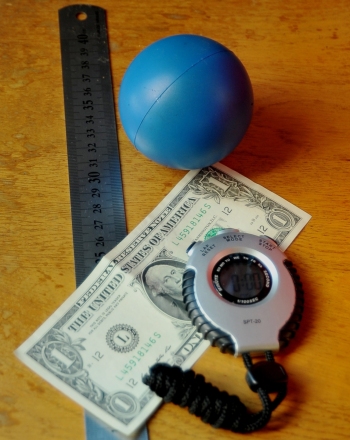Science project
Distance, Velocity and Time: Equations and Relationship
Do you remember the story of the tortoise and the hare? The tortoise and the hare decided to have a race. Everybody, most of all the hare, thought the hare would win the race because he hopped much faster than the tortoise plodded. We could say that the hare usually travelled at a much higher velocity than the tortoise. Velocity is the measure of the amount of distance an object covers in a given amount of time. Here's a word equation that expresses the relationship between distance, velocity and time: Velocity equals distance travelled divided by the time it takes to get there.
Confident that his high typical velocity would allow him to cover the race distance in a short amount of time, the hare took a lot of breaks. Looking at our equation, we can see that when time is increased—for any reason—overall velocity goes down. The tortoise never took any breaks: he just kept plodding along. By the time the hare realized that he was way behind the tortoise, it was too late. The tortoise won the race, and we all got the moral “Slow and Steady Wins the Race.” That’s a good lesson but the hare could have won the race (and still taken a few breaks) if he had only completed the experiment you are about to do.
Problem
Predict when a fast toy car can pass a slower toy car.
Materials:
- A smooth, clear, level stretch of floor (two 2-meter stretches of flat Hot Wheels track is even better)
- Assistant
- 2 toy cars with adjustable speeds
- Tape measure
- Stopwatch or timer
- Graph paper
- Pencil
- Ruler
Procedure
- Use your tape measure to mark off a distance of 1.5 meters from the starting line.
- Set one of your cars to a “slow” speed. Have your assistant start the timer when set the car down at the starting line.
- Watch the car carefully. It should travel in a straight line and at a constant velocity.
- When the slower car passes the 1.5 meter mark, have your assistant stop and record the time.
- Repeat this a second or third time to make sure you obtain a consistent velocity across all trials.
- Divide distance by time to determine the slower car’s velocity in meters per second.
- Set your second car to a faster speed than your first.
- Using your calculated velocities, you will now are going to determine how long your faster car could delay and still overtake the slower car.
- On the X axis of your graph paper, mark the time in ½ second increments from zero to two seconds beyond the time it took your slower car to complete the course. Make sure to make your graph large so you have room to expand it if necessary!
- On the Y axis, mark the distance in centimeters from zero to 150 centimeters. (Remember—150 centimeters is the same as 1.5 meters.)
- Plot the velocity of the slower car. Your first point should be at (0,20 cm) because you are going to give it a 20-cm head start.
- Your second point for the slow car is the velocity you measured. The X value should be whatever time it took for the car to reach the end of your test course, your Y value is the distance you had the car travel (1.5 meters).
- Using your ruler and pencil, connect the two points to make a line.
- Now, plot the velocity of the faster car. Your first point should be at (0,0 cm) because this car will not get a head start.
- Your second point for the fast car is the velocity you measured. The X value should be whatever time it took for the car to reach the end of your test course, your Y value is the distance you had the car travel (1.5 meters).
- Using your ruler and pencil connect the two points to make another line. Make this line look different than the first, either by making dashes or making it darker.
- Label the lines fast car and slow car.
- Find where the two lines cross. At this intersection point, trace one line to X axis, and another to the Y axis. These are the lines with arrows on diagram 1. The two values you see are the time and distance where the fast car should overtake the slower car. If your lines don’t cross in your graph, you need to shorten the slow car’s head to start to 10 or even 5 centimeters.
- Mark the predicting passing point on your course.
- Now, it’s time to test your prediction!
- Mark off the slow car’s head start point on your course.
- Mark off the calculated point where the faster car should overtake the slower car.
- Have your assistant release the slower car at the head start mark while you simultaneously release your faster car at the starting line. Start the timer (a third person might be nice for this).
- Watch carefully to see where the fast car overtakes the slow car.
- Compare your predicted time and distance that the fast car overtook the slower car with the actual values.
Results
Your results are likely to be pretty close to what your graph predicts, but they will likely vary depending on the velocities of your cars and whether or not they travel at a consistent velocity. Conduct more trials if you wish. If your graph still doesn’t match your actual results, you might want to re-measure the velocity of both your cars again and redraw your graph.
Why?
Uniform velocity is a linear function, making them easy (and fun) to predict. The steeper the slope of each function’s line, the faster the car each line represents. Although the slower car had a head start in distance, the faster car covered more distance in less time, so it caught up. This is where the lines crossed.
A non-graphical way of looking at this is using the following equation: d=d0 + vs(t-t0) where
- d is the total distance
- t is the total time
- d0 is the head start distance
- vs is the slower car’s velocity, and
- t0is the time in seconds for the head start.
The equation for the fast car is d= vf (t), where vf is the velocity of the fast car. The total distance each car travels to intersect is the same. So, if the hare had measured his hopping velocity and the tortoise’s plodding velocity, and the total race distance, he could have figured out how much of a head start he could have given the tortoise and still won.
Going Further
The next time you’re about to say “Are we there yet?” on a long car trip with your parents, ask them what the car’s velocity and trip distance is instead. Then, you can tell your parents how soon you will arrive at your destination.
Education.com provides the Science Fair Project Ideas for informational purposes only. Education.com does not make any guarantee or representation regarding the Science Fair Project Ideas and is not responsible or liable for any loss or damage, directly or indirectly, caused by your use of such information. By accessing the Science Fair Project Ideas, you waive and renounce any claims against Education.com that arise thereof. In addition, your access to Education.com's website and Science Fair Project Ideas is covered by Education.com's Privacy Policy and site Terms of Use, which include limitations on Education.com's liability.
Warning is hereby given that not all Project Ideas are appropriate for all individuals or in all circumstances. Implementation of any Science Project Idea should be undertaken only in appropriate settings and with appropriate parental or other supervision. Reading and following the safety precautions of all materials used in a project is the sole responsibility of each individual. For further information, consult your state's handbook of Science Safety.














